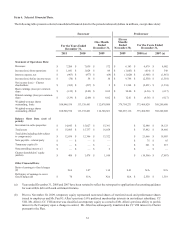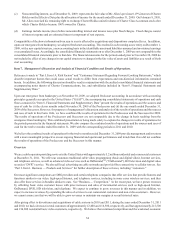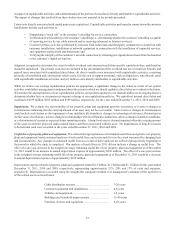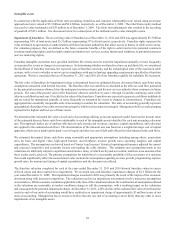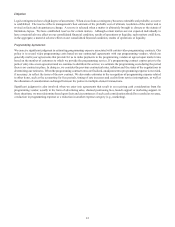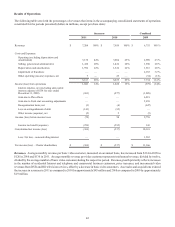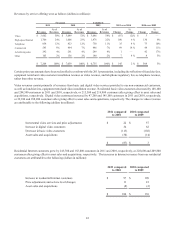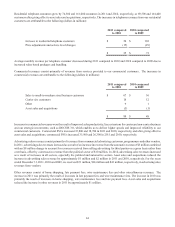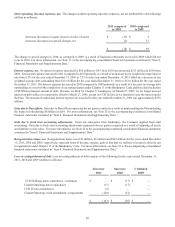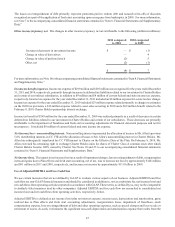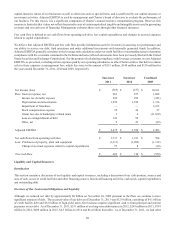Charter 2011 Annual Report Download - page 52
Download and view the complete annual report
Please find page 52 of the 2011 Charter annual report below. You can navigate through the pages in the report by either clicking on the pages listed below, or by using the keyword search tool below to find specific information within the annual report.40
The consummation of the Plan generated an “ownership change” as defined in Section 382 of the Code. As a result, Charter is
subject to limitation on the use of approximately 65% of its tax loss carryforwards. Further, Charter’s net operating loss
carryforwards have been reduced by the amount of the cancellation of debt income resulting from the Plan that was allocable to
Charter. The limitation on Charter’s ability to use its tax loss carryforwards, in conjunction with the loss expiration provisions,
could reduce its ability to use a portion of Charter’s tax loss carryforwards to offset future taxable income.
As of December 31, 2011, $2.6 billion of federal tax loss carryforwards are unrestricted and available for Charter’s immediate
use, while approximately $4.8 billion of federal tax loss carryforwards are still subject to Section 382 and other restrictions.
Pursuant to these restrictions, an aggregate of $1.5 billion, in varying amounts from 2012 to 2014, and an additional $176 million
annually over each of the next 17 years of federal tax loss carryforwards, should become unrestricted and available for Charter’s
use. Both Charter’s indirect corporate subsidiary and state tax loss carryforwards are subject to similar but varying restrictions.
In addition to its tax loss carry forwards, Charter also has tax basis of $4.3 billion in intangible assets and $5.0 billion in property,
plant, and equipment as of December 31, 2011. The tax basis in these assets is not subject to Section 382 limitations and therefore
the related amortization and depreciation is currently deductible. For illustrative purposes, Charter expects to reflect tax-deductible
amortization and depreciation on assets owned as of December 31, 2011, beginning at approximately $1.9 billion in 2012 and
decelerating over the following 4 years, totaling an estimated $6.6 billion over the five year period. The foregoing projected
deductions do not include any amortization or depreciation related to future capital spend or potential acquisitions. In addition,
the deductions assume Charter does not utilize accelerated or “ bonus” depreciation methods, dispose of a material portion of its
business, or make modifications to the underlying partnerships it owns, all of which may materially affect the timing or amount
of its existing amortization and depreciation deductions. Any one of these factors or future legislation or adjustments by the IRS
upon examination could also affect the projected deductions.
As of December 31, 2011 and 2010, we have recorded net deferred income tax liabilities of $824 million and $538 million,
respectively. Net deferred tax liabilities included approximately $221 million and $225 million at December 31, 2011 and 2010,
respectively, relating to certain indirect subsidiaries of Charter Holdco that file separate federal or state income tax returns. The
remainder of our net deferred tax liability arose from Charter's investment in Charter Holdco, and was largely attributable to the
characterization of franchises for financial reporting purposes as indefinite-lived. As part of our net liability, on December 31,
2011 and 2010, we had gross deferred tax assets of $3.8 billion and $3.7 billion, respectively, which primarily relate to tax losses
allocated to Charter from Charter Holdco. In assessing the realizability of deferred tax assets, management considers whether it
is more likely than not that some portion or all of the deferred tax assets will be realized. Due to our history of losses, we were
unable to assume future taxable income in our analysis and accordingly valuation allowances have been established except for
deferred benefits available to offset certain deferred tax liabilities that will reverse over time. Accordingly, our gross deferred tax
assets have been offset with a corresponding valuation allowance of $2.6 billion and $2.3 billion at December 31, 2011 and 2010,
respectively. The amount of the deferred tax assets considered realizable and, therefore, reflected in the consolidated balance
sheet, would be increased at such time that it is more-likely-than-not future taxable income will be realized during the carryforward
period. At the time this consideration is met, an adjustment to reverse some portion of the existing valuation allowance would
result.
In determining our tax provision for financial reporting purposes, Charter establishes a reserve for uncertain tax positions unless
such positions are determined to be “more likely than not” of being sustained upon examination, based on their technical merits.
In evaluating whether a tax position has met the more-likely-than-not recognition threshold, we presume the position will be
examined by the appropriate taxing authority that has full knowledge of all relevant information. A tax position that meets the
more-likely-than-not recognition threshold is measured to determine the amount of benefit to be recognized in our financial
statements. The tax position is measured at the largest amount of benefit that has a greater than 50% likelihood of being realized
when the position is ultimately resolved. There is considerable judgment involved in determining whether positions taken on the
tax return are “more likely than not” of being sustained. As of December 31, 2011 and 2010, we have recorded $228 million and
$224 million, respectively, of liabilities for uncertain tax positions.
Charter adjusts its uncertain tax reserve estimates periodically because of ongoing examinations by, and settlements with, the
various taxing authorities, as well as changes in tax laws, regulations and interpretations.
No tax years for Charter or Charter Holdco are currently under examination by the Internal Revenue Service. Tax years ending
2008 through 2011 remain subject to examination and assessment. Years prior to 2008 remain open solely for purposes of
examination of Charter’s net operating loss and credit carryforwards.





